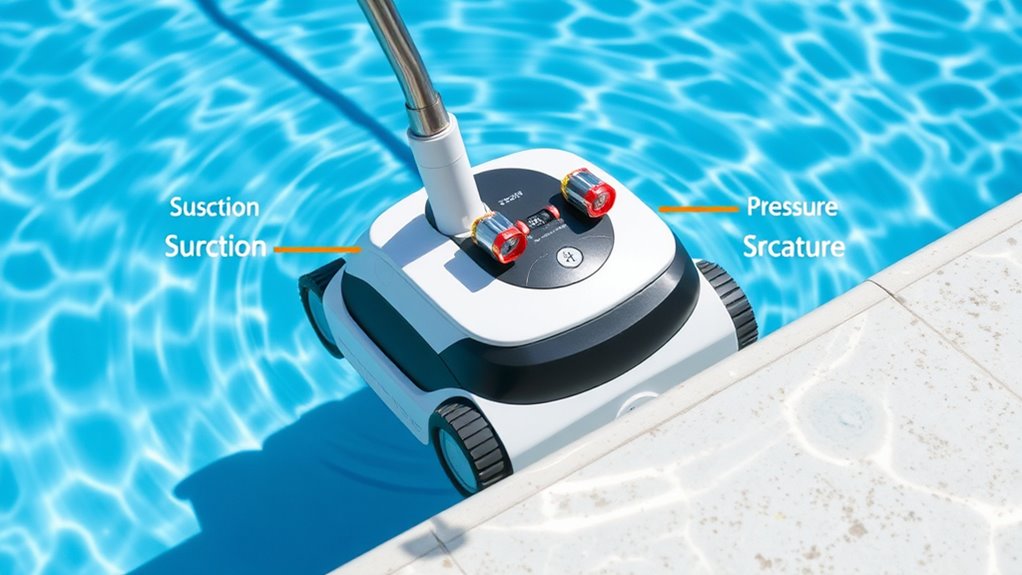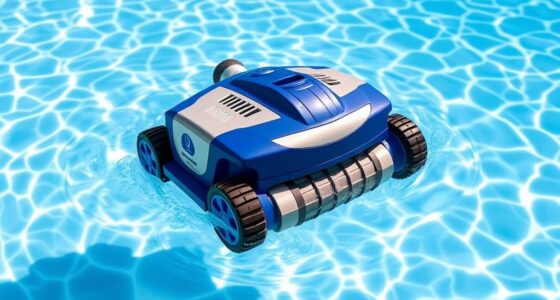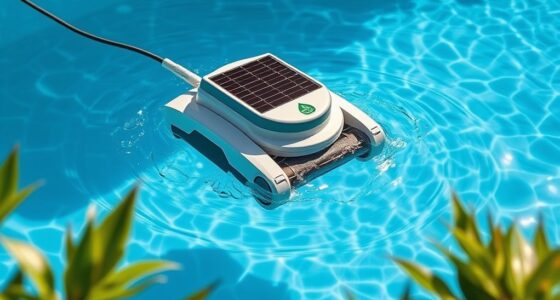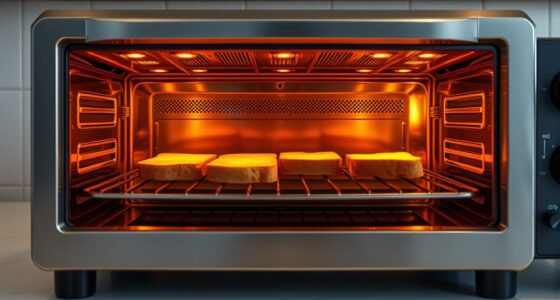Switching from a suction to a pressure pool cleaner improves your pool’s cleaning efficiency by covering larger areas and handling tougher debris like leaves and twigs more effectively. You’ll need to set up hoses and support equipment, and regular checks of hoses and connections help maintain performance. While pressure cleaners typically use more power, they clean faster and more thoroughly. Keep exploring to discover how to get the most out of your new system.
Key Takeaways
- Ensure your pool’s pump and filtration system can support a pressure cleaner, often requiring a dedicated booster pump.
- Disconnect and remove the suction-side cleaner before installing the pressure pool cleaner.
- Connect the pressure cleaner’s hose to the dedicated return line or booster pump for optimal operation.
- Regularly check hoses and connections for leaks or clogs to maintain cleaning efficiency.
- Adjust your pool’s circulation settings to accommodate the pressure cleaner and maximize debris removal.
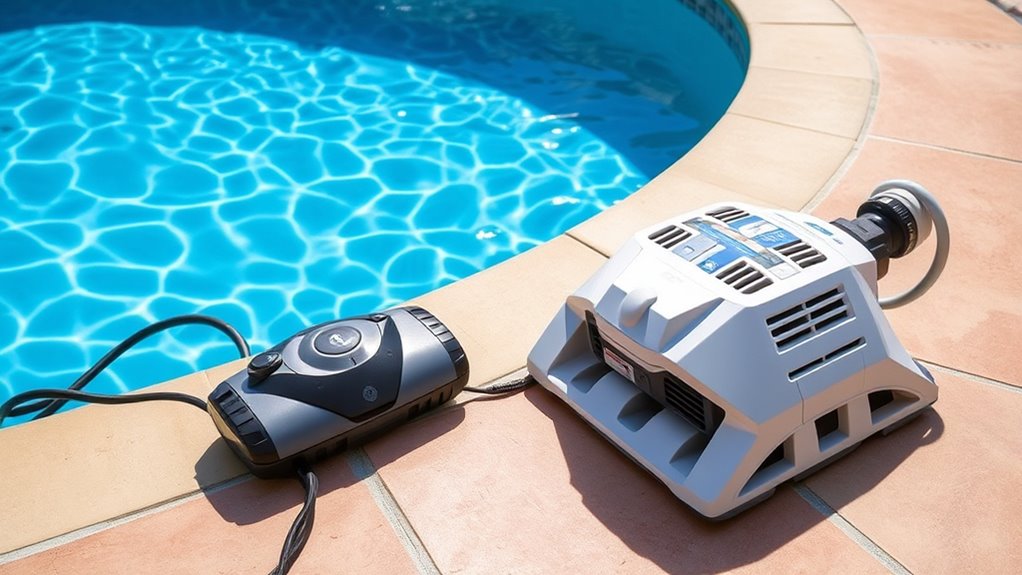
If you’re contemplating switching from a suction pool cleaner to a pressure one, you’ll find that the shift can greatly improve your pool’s cleanliness and maintenance efficiency. Pressure cleaners tend to cover more area and handle dirt more effectively, reducing the time you spend manually cleaning. One of the key benefits is that they often require less frequent maintenance because they operate with fewer moving parts and less strain on their components. When evaluating this switch, it’s important to think about how the change impacts your pool cleaner maintenance routine. Pressure pool cleaners typically have more robust parts, which means they might last longer with proper care, but they also need regular checks of hoses and connections to prevent leaks and clogs.
Energy efficiency is another vital factor. Pressure cleaners usually use more power than suction models because they rely on a dedicated booster pump to generate the necessary pressure. However, because they clean more thoroughly and faster, you might find that the overall energy used per cleaning session is lower, especially if you tend to run your cleaner for extended periods with a suction system. Modern pressure cleaners are often designed with energy efficiency in mind, featuring adjustable settings or intelligent controls that allow you to optimize power use. This means you can balance thorough cleaning with lower energy consumption, ultimately saving you money on your electricity bill. Additionally, investing in a smart pool cleaner can further enhance energy savings and cleaning performance.
Switching to a pressure pool cleaner can also influence your pool’s overall maintenance routine. Since they tend to pick up debris more effectively and reach difficult spots, you’ll spend less time on manual skimming or vacuuming. This can lead to a cleaner pool with less chemical imbalance caused by debris buildup. Additionally, pressure cleaners are generally better at handling larger debris, such as leaves or twigs, which might clog or slow down suction cleaners. With less frequent interruptions for maintenance, your pool stays cleaner longer, reducing the overall effort needed to keep it in top shape. Incorporating proper noise reduction technology can also make using a pressure cleaner more comfortable and less disruptive.
However, it’s worth noting that pressure cleaners require a bit more setup and space for hoses and additional equipment. You’ll need to make sure your pump system can support the extra demand without compromising energy efficiency. Regular pool cleaner maintenance, including inspecting hoses and cleaning filters, becomes even more important to keep everything running smoothly. With proper care, a pressure cleaner can be a valuable upgrade that enhances your pool’s cleanliness, reduces your effort, and promotes better energy efficiency over time.
Frequently Asked Questions
How Do I Determine if My Pool Needs a Pressure Cleaner?
To determine if your pool needs a pressure cleaner, consider your pool size and debris type. If you have a large pool with heavy or stubborn debris like leaves or algae, a pressure cleaner works better than a suction one. For small pools or light debris, a suction cleaner might suffice. If your current cleaner isn’t efficiently handling your debris, switching to a pressure cleaner could improve your pool’s cleanliness.
Can I Switch Between Suction and Pressure Cleaners Easily?
Ever wondered if you can switch between suction and pressure cleaners easily? You can, but it depends on your vacuum compatibility and hose connection. Check if your pool’s skimmer and pump setup support both types, and verify your hoses fit properly. Most pools allow quick switching, but you’ll need the right adapters or fittings. So, yes, with the right equipment, switching is straightforward, making pool maintenance more flexible and efficient.
What Maintenance Differences Exist Between Suction and Pressure Pool Cleaners?
You’ll find that maintenance differs between suction and pressure pool cleaners. Suction cleaners typically require regular filter maintenance because debris clogs the skimmer basket and filter more often. Pressure cleaners need pump inspection to ensure the pressure side is functioning correctly, and their hoses should be checked for leaks. Both types benefit from routine cleaning of hoses and brushes, but pressure cleaners often demand more frequent pump inspection to maintain peak performance.
Are Pressure Pool Cleaners Compatible With All Types of Pools?
You might wonder if pressure pool cleaners work with all pools. While they’re versatile, compatibility depends on your pool’s size, shape, and plumbing. Proper pool chemistry ensures ideal performance and reduces wear. Pressure cleaners are generally energy-efficient, saving you money over time. Check your pool’s specifications and consult a professional to confirm compatibility, guaranteeing your cleaner operates smoothly and maintains your pool’s cleanliness effectively.
How Long Does It Take to Install a Pressure Pool Cleaner?
You might be surprised how quickly you can install a pressure pool cleaner—often within an hour. The installation time depends on your pool setup and your familiarity with tools. Usually, you’ll need basic tools like a screwdriver and hose fittings. If you follow the manufacturer’s instructions carefully, you’ll find the process straightforward, making it easy to get your cleaner up and running without much hassle.
Conclusion
Switching from a suction to a pressure pool cleaner will completely revolutionize your pool maintenance! Imagine never battling tangled hoses or struggling with weak suction again—your pool will sparkle brighter than a diamond in the sun, and cleaning will become so effortless, you’ll wonder how you ever managed otherwise. Don’t settle for less; make the switch today and reveal the secret to a perfectly pristine pool with a cleaner that works harder than you ever thought possible!
